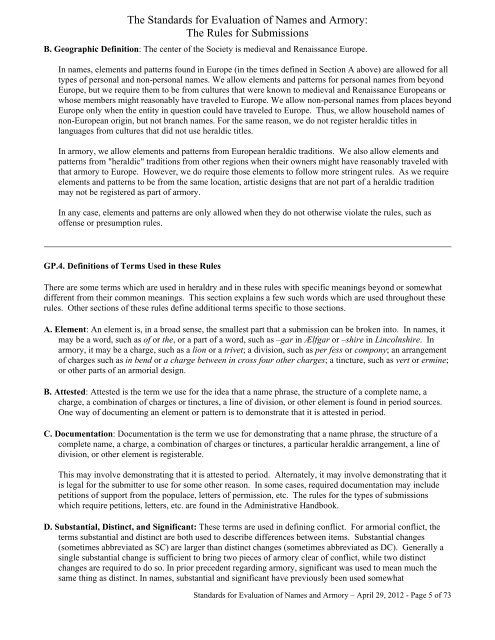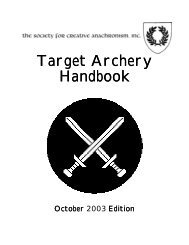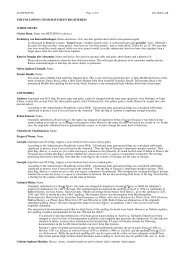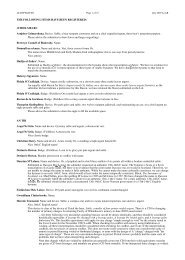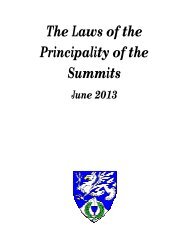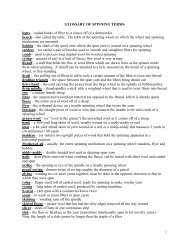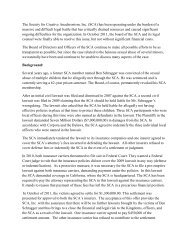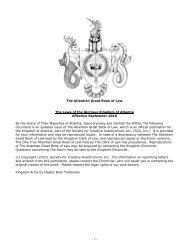The Standards for Evaluation of Names and Armory - SCA Heraldry
The Standards for Evaluation of Names and Armory - SCA Heraldry
The Standards for Evaluation of Names and Armory - SCA Heraldry
You also want an ePaper? Increase the reach of your titles
YUMPU automatically turns print PDFs into web optimized ePapers that Google loves.
<strong>The</strong> <strong>St<strong>and</strong>ards</strong> <strong>for</strong> <strong>Evaluation</strong> <strong>of</strong> <strong>Names</strong> <strong>and</strong> <strong>Armory</strong>:<strong>The</strong> Rules <strong>for</strong> SubmissionsB. Geographic Definition: <strong>The</strong> center <strong>of</strong> the Society is medieval <strong>and</strong> Renaissance Europe.In names, elements <strong>and</strong> patterns found in Europe (in the times defined in Section A above) are allowed <strong>for</strong> alltypes <strong>of</strong> personal <strong>and</strong> non-personal names. We allow elements <strong>and</strong> patterns <strong>for</strong> personal names from beyondEurope, but we require them to be from cultures that were known to medieval <strong>and</strong> Renaissance Europeans orwhose members might reasonably have traveled to Europe. We allow non-personal names from places beyondEurope only when the entity in question could have traveled to Europe. Thus, we allow household names <strong>of</strong>non-European origin, but not branch names. For the same reason, we do not register heraldic titles inlanguages from cultures that did not use heraldic titles.In armory, we allow elements <strong>and</strong> patterns from European heraldic traditions. We also allow elements <strong>and</strong>patterns from "heraldic" traditions from other regions when their owners might have reasonably traveled withthat armory to Europe. However, we do require those elements to follow more stringent rules. As we requireelements <strong>and</strong> patterns to be from the same location, artistic designs that are not part <strong>of</strong> a heraldic traditionmay not be registered as part <strong>of</strong> armory.In any case, elements <strong>and</strong> patterns are only allowed when they do not otherwise violate the rules, such as<strong>of</strong>fense or presumption rules.GP.4. Definitions <strong>of</strong> Terms Used in these Rules<strong>The</strong>re are some terms which are used in heraldry <strong>and</strong> in these rules with specific meanings beyond or somewhatdifferent from their common meanings. This section explains a few such words which are used throughout theserules. Other sections <strong>of</strong> these rules define additional terms specific to those sections.A. Element: An element is, in a broad sense, the smallest part that a submission can be broken into. In names, itmay be a word, such as <strong>of</strong> or the, or a part <strong>of</strong> a word, such as –gar in Ælfgar or –shire in Lincolnshire. Inarmory, it may be a charge, such as a lion or a trivet; a division, such as per fess or compony; an arrangement<strong>of</strong> charges such as in bend or a charge between in cross four other charges; a tincture, such as vert or ermine;or other parts <strong>of</strong> an armorial design.B. Attested: Attested is the term we use <strong>for</strong> the idea that a name phrase, the structure <strong>of</strong> a complete name, acharge, a combination <strong>of</strong> charges or tinctures, a line <strong>of</strong> division, or other element is found in period sources.One way <strong>of</strong> documenting an element or pattern is to demonstrate that it is attested in period.C. Documentation: Documentation is the term we use <strong>for</strong> demonstrating that a name phrase, the structure <strong>of</strong> acomplete name, a charge, a combination <strong>of</strong> charges or tinctures, a particular heraldic arrangement, a line <strong>of</strong>division, or other element is registerable.This may involve demonstrating that it is attested to period. Alternately, it may involve demonstrating that itis legal <strong>for</strong> the submitter to use <strong>for</strong> some other reason. In some cases, required documentation may includepetitions <strong>of</strong> support from the populace, letters <strong>of</strong> permission, etc. <strong>The</strong> rules <strong>for</strong> the types <strong>of</strong> submissionswhich require petitions, letters, etc. are found in the Administrative H<strong>and</strong>book.D. Substantial, Distinct, <strong>and</strong> Significant: <strong>The</strong>se terms are used in defining conflict. For armorial conflict, theterms substantial <strong>and</strong> distinct are both used to describe differences between items. Substantial changes(sometimes abbreviated as SC) are larger than distinct changes (sometimes abbreviated as DC). Generally asingle substantial change is sufficient to bring two pieces <strong>of</strong> armory clear <strong>of</strong> conflict, while two distinctchanges are required to do so. In prior precedent regarding armory, significant was used to mean much thesame thing as distinct. In names, substantial <strong>and</strong> significant have previously been used somewhat<strong>St<strong>and</strong>ards</strong> <strong>for</strong> <strong>Evaluation</strong> <strong>of</strong> <strong>Names</strong> <strong>and</strong> <strong>Armory</strong> – April 29, 2012 - Page 5 <strong>of</strong> 73


